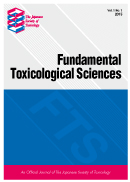
- |<
- <
- 1
- >
- >|
-
Wataru Yoshioka, Mayuko Nagamura, Ryosuke Tanino, Akinari Shimada, Kim ...2022Volume 9Issue 7 Pages 197-202
Published: 2022
Released on J-STAGE: December 02, 2022
JOURNAL FREE ACCESSHyperuricemia, an elevated urate concentration in blood, is the precursor state of gout and is associated with metabolic syndrome and chronic kidney disease. The increasing prevalence of hyperuricemia in recent years is thought to be due to environmental factors, particularly diet. Here, we investigated whether and how fructose induces an increase in plasma urate concentration using a rat model. Oral administration of fructose increased plasma urate concentration within 15–30 min, without an increase in urate excretion into urine or gastrointestinal tract, and this action was evident at a dose of 7.5 g/kg b.w. On the other hand, the same dose of glucose did not elicit a hyperuricemic effect at all, and thus the effect is thought to be a specific property of fructose. The absence of an increase in urinary or gastrointestinal excretion suggested that the increase did not result from an increase in urate production. Instead, a decrease in urate clearance could have a potential to explain the increase in plasma urate concentration. In conclusion, the present study characterized the time course and dose response of a fructose-induced increase in plasma urate concentration using a rat model.
View full abstractDownload PDF (766K)
-
Xiaobo Han, Naoki Matsuda, Kazuki Matsuda, Makoto Yamanaka, Ikuro Suzu ...2022Volume 9Issue 7 Pages 203-209
Published: 2022
Released on J-STAGE: December 23, 2022
JOURNAL FREE ACCESSIn this study, a microfluidic culture device and related evaluation methods were developed using deep learning to construct a rapid assessment platform for peripheral neuropathy caused by typical anticancer drugs. Primary rodent dorsal root ganglia were cultured in a microfluidic culture device that separated the cell body and neurites, and morphological changes in the neuritis were analyzed using immunofluorescence imaging. Successful culture of separated neurites in the microfluidic device for more than 1 month indicated that this test process, including culture, drug stimulation, and fluorescence observation, results in a viable outcome. In addition, cultured samples were treated with several anticancer drugs known to cause peripheral neurotoxicity (i.e., vincristine, oxaliplatin, and paclitaxel), and morphological changes in the neuritis were analyzed using deep learning for image analysis. After training, artificial intelligence (AI) could identify morphological changes in the neurites caused by each compound and precisely predict toxicity, even at low concentrations. For the test compounds, AI could also precisely detect neurotoxicity based on neurite images, even at low concentrations. Our results suggest that this microfluidic culture system is useful for in vitro toxicity assessment.
View full abstractDownload PDF (3190K)
- |<
- <
- 1
- >
- >|